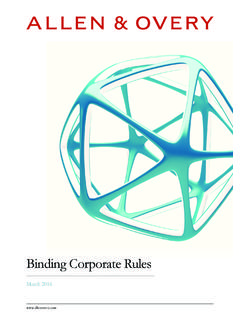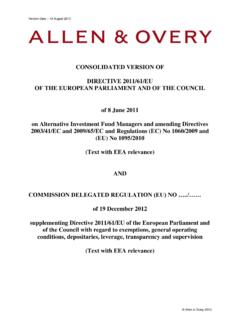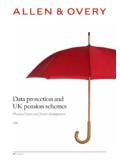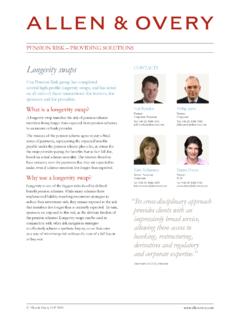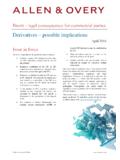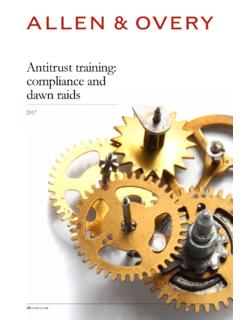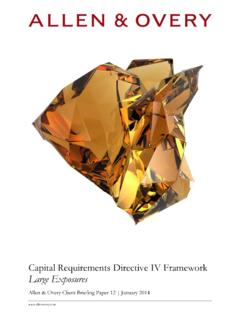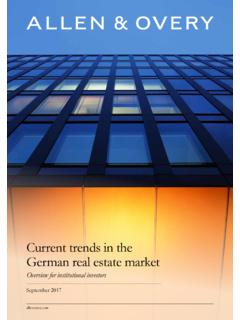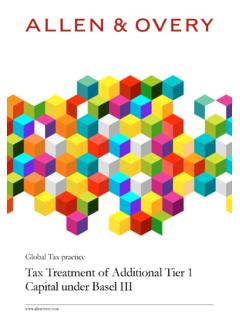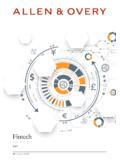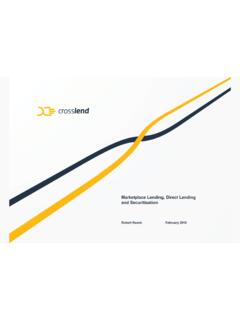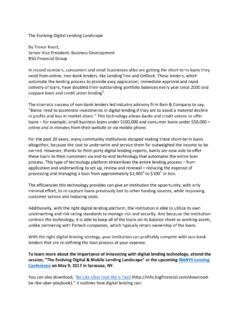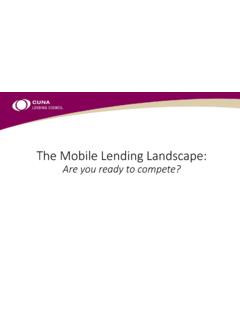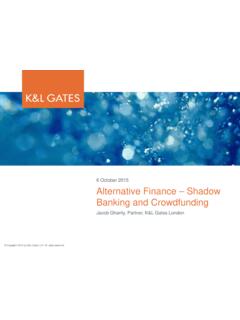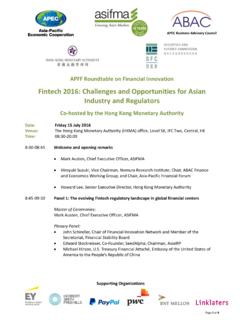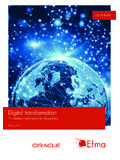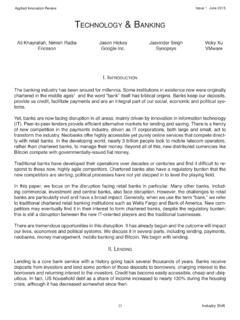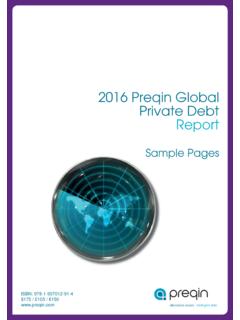Transcription of Corporate funding monitor 2016 - Allen & Overy
1 Corporate funding monitor 2016 The changing face of financeJanuary volatility and complexity, corporates continue to have funding optionsLooking back, 2015 was quite a year. Financial markets were volatile as they absorbed an onslaught of new risks, from the growth slowdown in China to the collapse in oil prices. A series of heavy new financial regulations, designed to reshape the sector, also came into effect early in the year. Yet, Corporate funding still reached near record levels at trillion, according to Thomson Reuters data analysed for this report. This is only the second time combined financing has exceeded USD6tn and just 6% down on the peak achieved in 2014. Companies found they could raise money more cheaply and in more ways than ever before. The new normal that is emerging for Corporate funding is a lot more complex than it used to be, but it s clearest trend in 2015, strong in both the and Europe, was the return of investment grade loans as the largest source of funding for high quality corporates, up 6% to pushing close to the pre-crisis peak of in also saw the value of investment grade loans exceed the value of investment grade bonds for only the second time since the financial increase was driven by the merger and acquisitions (M&A) boom and, in particular, the return of megadeals such as Anheuser-Busch Inbev s bid for SABM iller and Royal Dutch Shell s bid for BG.
2 These deals required large-scale short-term bridge financing which made up a sizeable share of the total: of the USD360 billion lent in the top 20 investment grade deals, 38% was bridge finance. M&A was also the driving force behind a record year for follow-on equity issues, which reached close to USD450bn for the first time in bulge in short-term finance has resulted in a sharp rise in the number of loans scheduled to mature in 2016 . Almost USD860bn of investment grade loans matures in 2016 , compared with half of that amount in ,0001,000,0001,500,0002,000,0002,500,000 3,000,0003,500,0004,000,000 EquityBondsLoans201520142013201220112010 2009200820072006 Corporate funding by source, global (USDm)The Allen & Overy Corporate funding monitor looks at loan, bond and equity issues to non-financial corporates over the past decade to see what impact regulatory pressures, bank deleveraging and the emergence of alternative sources of finance have had on the way companies access funding .
3 The data is taken from Thomson Reuters and excludes funding to financial and real estate funding monitor 20162 Allen & Overy LLP 2016 Even with the prospect of rising interest rates in the , however, refinancing risk will remain low for investment-grade corporates for three reasons. First, the increases look set to follow a gradual path. The Federal Reserve s own projections imply rates around by the end of 2017 and over the longer term still far lower than the peaks seen over the past few decades. In Europe a further round of quantitative easing was ushered in last year, increasing the volume of cheap debt available for corporates. Meanwhile the UK looks set to hold off a little longer before it begins to raise its rates. No matter how you look at it, it will be a long-time before corporates have to worry about interest rates approaching 5%, as they were interest rate history and FOMC projections01234567201820162014201220102 008200620042002%FOMC participants median projection for Fed Funds Target RateSource: Bloomberg, Federal reserveFed Funds Target , the maturity profile for both bonds and loans is very stable over the next five years with roughly USD3tn of debt maturing each year.
4 Most of this is likely to be rolled over before reaching maturity to take advantage of still-low interest rates. In summary, investors appetite for investment-grade paper, the historic resilience of the high-yield and leveraged loan markets and access to various forms of alternative finance, means there should be adequate demand to meet the pipeline of maturing debt over the next 12 months. Many commentators also anticipate the appetite for M&A will continue in 2016 . For investment grade borrowers, a modest increase in rates will make little difference to the affordability or availability of funding . Banks remain keen to finance good-quality deals and there is increasing competition to finance mid-market deals they might previously have considered too smallThis reflects the diminishing returns on top-end large deals, where margins are currently very low and making a loan is often only attractive as an entry ticket to a broader and more-profitable cross-selling relationship with the borrower.
5 Five-year maturities for bonds and loans global (USDm)0500,0001,000,0001,500,0002,000,00 02,500,000 BondsLoans20202019201820172016 Corporate funding monitor 20164 Allen & Overy LLP 2016 One post-crisis trend the 2015 M&A-fuelled boom in short-term finance has reversed is the primacy of bonds in the investment grade market. Pre-financial crisis the value of loans was double the value of bonds. As the credit crunch of 2007 gave way to a full financial crisis, markets dislocated and investment grade corporates turned to bonds to meet their funding needs in record numbers. Over the past three years the volatile post-crisis relationship between loans and bonds, looks to have settled with the value of bond issues and loans to investment grade borrowers stabilising to a position of , as anticipated, the short-term bridge loans used to fund the M&A boom are refinanced in the bond markets during 2016 , bonds will most likely take pole position again.
6 But the difference in value between loans and bonds will likely remain currents continue to fluctuate depending on which prevailing events and conditions have the strongest pull on the tidal flow of funds. But one thing is clear corporates have options and are willing to use any and all of them as necessary. Investment grade financing global (USDm)0500,0001,000,0001,500,0002,000, flexibility in European funding While investment-grade lending soared, other parts of the market have not been without their challenges, most notably in leveraged loans, which dropped sharply in 2015 after two years of strong demand in the high-yield bond and leveraged loan market collapsed late last year, driven largely by the deterioration of the oil and commodities sectors. Also, investment banks were unable to syndicate financing commitments made in relation to several large leveraged buyouts, further dampening the market.
7 New leveraged lending guidelines from the Federal Reserve on maximum acceptable leverage for deals, also contributed to a drop of 38% year-on-year for new leveraged loans. Meanwhile the European high yield and leveraged loan market has been somewhat insulated from these circumstances, although it had to contend with the volatility resulting from the Greek grade lending will remain more vulnerable to uncertainty and tighter credit conditions than investment grade loans, but the drop in leverage deals has not scuppered the trend towards greater flexibility in the European market. Indeed, covenant-lite loans accounted for around half of European leveraged lending in 2015 according to S&P Capital IQ. There has been a well established tradition of trends being exported to Europe. While European credits have historically tended to tap the markets for better terms, 2015 saw some of that flow begin to reverse.
8 QE and lower prevailing interest rates in Europe could attract more credits to the European high-yield market, with structures that are increasingly familiar to American corporates, due to lower all-in-yields. The strength of the dollar may also make issuing Euro denominated debt attractive for companies with dollar revenues. Finally, European high-yield funds have been less invested in the oil and commodities sectors, and as a result have been somewhat insulated from the volatility that has affected their key development has been the maturing of the European high-yield bond market. Although issuance dropped markedly to USD80bn from USD124bn in 2014, the value of high-yield bonds has more than trebled from just USD26bn 10 years ago, and now accounts for around one-fifth of the wider European Corporate bond market.
9 Issuing a high-yield bond for general Corporate financing requirements is now an acceptable alternative to bank lending for any sub-investment grade borrower in Europe, whereas historically it was predominantly viewed as a tool for financing leveraged buyouts. High yield has also become attractive for smaller issuers and deals, which should ensure that the market continues to grow despite greater investor appetite for covenant-lite loans and a shift to alternative growth of the European high-yield market may well be aided by the addition of issuers over the next couple of years. Despite headwinds, the high-yield market should also remain the well established feature of the markets it has always been. Spreads have been rising, especially among the lowest-rated issuers, and investors are becoming more selective, but this largely reflects the problems in the oil & gas and mining sectors (which account for a larger share of high-yield issuance in the than in Europe) caused by falling commodity prices.
10 The difficulties in these sectors are unlikely to result in widespread contagion and drastically reduced liquidity. Meanwhile, rising interest rates will be counteracted by the strengthening economy that is causing them to rise traditionally a positive environment for high yield in the new normalThe structure and sources of Corporate funding have changed dramatically since the financial crisis, responding to fast-shifting market dynamics and regulations. Despite the ups-and-downs, the overall level of funding has stabilised and the data are starting to show patterns and trends that look set to continue. While banks still have to work to find profits, corporates are enjoying easier and cheaper access to investment-grade loans if they are eligible, and a wider variety of sub-investment grade alternatives if they are not.
